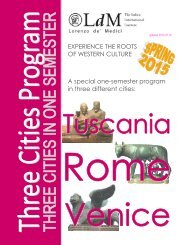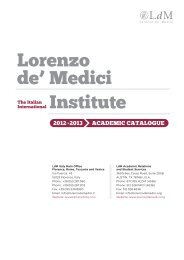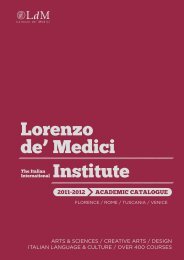aCademiC Catalog 2013-2014 - Lorenzo de Medici
aCademiC Catalog 2013-2014 - Lorenzo de Medici
aCademiC Catalog 2013-2014 - Lorenzo de Medici
Create successful ePaper yourself
Turn your PDF publications into a flip-book with our unique Google optimized e-Paper software.
FLORENCE<br />
School of Arts & Sciences<br />
or she may begin the internship. While stu<strong>de</strong>nts may initiate<br />
the internship anytime after the approval of the Master’s<br />
Thesis prospectus, most will opt to un<strong>de</strong>rtake the bulk of this<br />
work experience once they have completed their Spring term<br />
courses as they will have more time and more flexibility to offer<br />
their host institution. The stu<strong>de</strong>nt will choose an internship of<br />
a minimum of 200 hours which will bring her/him in contact<br />
with a real working museum institution, giving her/him the<br />
opportunity to test the theoretical knowledge and the practical<br />
skills acquired while taking “Museums and the Public II: Objects<br />
and Audience”. The internship may be completed. in Florence<br />
or elsewhere and will be jointly supervised by LdM staff and<br />
the host institution. All approved internships will comply with<br />
Italian health and safety co<strong>de</strong>s. Stu<strong>de</strong>nts who wish to intern in<br />
Florence are strongly encouraged to enroll in Italian language<br />
courses during the aca<strong>de</strong>mic year in Florence or elsewhere and<br />
will be jointly supervised by LdM staff and the host institution.<br />
Note: Placement opportunities are limited and subject<br />
to change. Stu<strong>de</strong>nts who enroll must submit supporting<br />
documentation by the registration <strong>de</strong>adline, and acceptance is<br />
conditional upon result of an onsite interview during the first<br />
week of the term. Fluency in Italian may be advantageous.<br />
Master’s Thesis<br />
ART 625 F<br />
Cr: 4; Contact hrs:<br />
Upon the successful completion of “Research Methods II: The<br />
Thesis Proposal” in which the stu<strong>de</strong>nt’s thesis prospectus is<br />
approved and his faculty advisor chosen, he or she may begin<br />
to research and write the masters thesis. This course has no<br />
formal requirements other than periodic meetings with the<br />
faculty advisor and many hours of research, writing and revising.<br />
Communications<br />
Public Speaking and Presentation Skills<br />
COM 105 F<br />
Cr: 3; Contact hrs: 45<br />
This course provi<strong>de</strong>s an introduction to public speaking in group<br />
and whole-class situations. It will help stu<strong>de</strong>nts to <strong>de</strong>velop their<br />
<strong>de</strong>livery skills as well as the content of their presentations,<br />
including the <strong>de</strong>velopment and organization of i<strong>de</strong>as and<br />
use of research material. Stu<strong>de</strong>nts will analyze a variety of<br />
speeches, in written and oral formats, and will be required to<br />
<strong>de</strong>velop working outlines for their own presentations. Classes<br />
will also involve voice and body language exercises and will<br />
teach strategies for overcoming performance anxiety.<br />
Introduction to Communication<br />
COM 130 F<br />
Cr: 3; Contact hrs: 45<br />
This course surveys the theories of communication relevant<br />
to all contexts (including interpersonal, group, organizational,<br />
mediated, and cultural) and the ways in which contexts affect<br />
the form of communication. The course introduces stu<strong>de</strong>nts to<br />
essential concepts and fundamental theories that <strong>de</strong>scribe the<br />
processes, functions, natures, and effects of communication.<br />
General goals of the course are to familiarize stu<strong>de</strong>nts with<br />
the basic concepts of communication and to help them<br />
un<strong>de</strong>rstand and improve basic skills in relation to interpersonal<br />
communication. Stu<strong>de</strong>nts <strong>de</strong>al with ethical issues and global<br />
opportunities and challenges offered by communication, and<br />
they have an opportunity to <strong>de</strong>velop their critical thinking and<br />
writing, as well as group work and presentation skills.<br />
Foundations of Visual Communication<br />
COM 175 F; Dual listed: GRA 190 F<br />
Cr: 3; Contact hrs: 90<br />
This course is essential for all stu<strong>de</strong>nts that, either as beginners<br />
in graphic <strong>de</strong>sign or with previous experience in digital graphics,<br />
<strong>de</strong>sire to learn the secrets of “good <strong>de</strong>sign.” The aim of the<br />
course is to assist stu<strong>de</strong>nts in <strong>de</strong>veloping intellectual skills and<br />
familiarity with the rules which un<strong>de</strong>rpin the creation of graphic<br />
works that convey both aesthetic quality and communicative<br />
power. The course is structured into a series of projects, lectures,<br />
analyses and drawing exercises which, through the application<br />
and study of <strong>de</strong>sign theories, aim at offering stu<strong>de</strong>nts a<br />
methodology for solving graphic and visual projects. Topics<br />
inclu<strong>de</strong>: B/W techniques, layouts and grids, colors and shape<br />
balance, mirror and rotational symmetries, repetitive patterns,<br />
archetypes and primary shapes, fonts and typography, studies<br />
of visual languages and cultural backgrounds, analysis of styles<br />
and artwork, rules to <strong>de</strong>rive families of shapes and colors,<br />
formats and harmonic proportions such as the diagonal of<br />
the square, icons, logotypes and tra<strong>de</strong>marks, studies of 3D<br />
mo<strong>de</strong>ls and packaging. The course places emphasis on the<br />
learning of graphic <strong>de</strong>sign principles and concepts that are<br />
in<strong>de</strong>pen<strong>de</strong>nt from the tools used for production (digital or<br />
manual techniques). There is a focus on learning from the great<br />
tradition of Italian <strong>de</strong>sign, and the stu<strong>de</strong>nt is encouraged to<br />
make the most of the visual and cultural experience offered by<br />
the city of Florence.<br />
Foundations of Visual Communication<br />
(Summer only)<br />
COM 176 F; Dual listed: GRA 191 F<br />
Cr: 3; Contact hrs: 45<br />
This course is essential for all stu<strong>de</strong>nts that, either as beginners<br />
in graphic <strong>de</strong>sign or with previous experience in digital graphics,<br />
<strong>de</strong>sire to learn the secrets of “good <strong>de</strong>sign.” The aim of the<br />
course is to assist stu<strong>de</strong>nts in <strong>de</strong>veloping intellectual skills and<br />
familiarity with the rules which un<strong>de</strong>rpin the creation of graphic<br />
works that convey both aesthetic quality and communicative<br />
power. The course is structured into a series of projects, lectures,<br />
analyses and drawing exercises which, through the application<br />
and study of <strong>de</strong>sign theories, aim at offering stu<strong>de</strong>nts a<br />
methodology for solving graphic and visual projects. Topics<br />
inclu<strong>de</strong>: B/W techniques, layouts and grids, colors and shape<br />
balance, mirror and rotational symmetries, repetitive patterns,<br />
archetypes and primary shapes, fonts and typography, studies<br />
of visual languages and cultural backgrounds, analysis of styles<br />
and artwork, rules to <strong>de</strong>rive families of shapes and colors,<br />
formats and harmonic proportions such as the diagonal of<br />
the square, icons, logotypes and tra<strong>de</strong>marks, studies of 3D<br />
mo<strong>de</strong>ls and packaging. The course places emphasis on the<br />
learning of graphic <strong>de</strong>sign principles and concepts that are<br />
in<strong>de</strong>pen<strong>de</strong>nt from the tools used for production (digital or<br />
manual techniques). There is a focus on learning from the great<br />
tradition of Italian <strong>de</strong>sign, and the stu<strong>de</strong>nt is encouraged to<br />
make the most of the visual and cultural experience offered by<br />
the city of Florence.<br />
Mass Communication<br />
COM 180 F<br />
Cr: 3; Contact hrs: 45<br />
This is an introductory course to mass communication, focusing<br />
on a wi<strong>de</strong> range of old and new media. Thus, the major themes<br />
will be two: “traditional” media (newspapers, magazines, radio,<br />
telephone, Motion Pictures, TV) and “digital” media (personal<br />
computers, Internet, digital TV). Through a “social history” of<br />
the <strong>de</strong>velopment of mass communication, much attention will<br />
be paid to the “convergence” of old and new, as well as the most<br />
relevant marketing topics (product marketing, advertising). The<br />
course will show how technological changes have influenced<br />
mass media in mo<strong>de</strong>rn times by increasing their variety and<br />
power. Secondly, it will examine how these changes brought<br />
about new communication possibilities, either as completely<br />
new concepts or in conjunction with existing media. Finally,<br />
the main cultural changes resulting from this evolution will<br />
be analyzed and discussed with regards to individual and<br />
social changes, and political and economic impact and the<br />
role of information in our society. Semiotics is fundamental to<br />
approaching mass communication as a wi<strong>de</strong>-scale linguistic<br />
phenomenon in which transmitters, receivers and messages<br />
can be i<strong>de</strong>ntified, analyzed and critically interpreted at any<br />
possible level.<br />
New Media: Communication in the Digital Age<br />
COM 182 F<br />
Cr: 3; Contact hrs: 45<br />
What do we really mean when we use the term “mass media”<br />
today? Is it really the same thing we could have meant twenty<br />
years ago, when television was still the main tool for mass<br />
information? The digital age has introduced new communication<br />
<strong>de</strong>vices (laptops, digital cameras, smart phones, iPods, iPads)<br />
58<br />
LdM Aca<strong>de</strong>mic <strong>Catalog</strong> <strong>2013</strong>-<strong>2014</strong>





